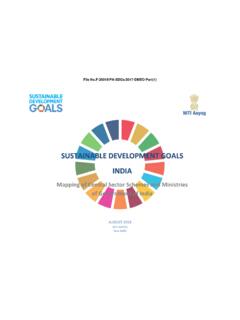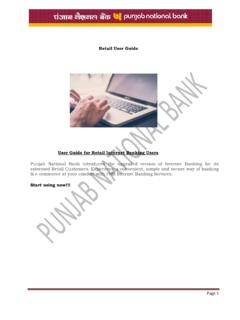Transcription of Current fraud trends in the financial sector - pwc
1 Current fraud trends in the financial sector June 20152 PwCContentsFinancial services megatrends 04 Transformation through technology: The advent of a new world of financial services 08 Frauds in financial institutions: Understanding the types and modus operandi 10 Regulatory and legislative landscape 19 Global trends in fraud prevention and detection 21 Message from ASSOCHAMF orewordIn the globalised and liberalised business environment of the last few years, we face a drastically increasing volume of frauds, especially in the financial sectors in India.
2 The Indian financial services sector has witnessed exponential growth in the last decade a growth that has not been without its pitfalls, as incidents of fraud have also been on the rise. fraud results in significant losses to the public exchequer, thus adversely affecting service fraud is big business, contributing to an estimated 20 billion USD in direct losses annually. Industry experts suspect that this figure is actually much higher, as firms cannot accurately identify and measure losses due to fraud . The worst effect of financial frauds is on FDI inflows into India. The time has come for financial services organisations to pursue a more strategic approach to fraud management within. To overcome this challenge, they need strict and focussed steps. There needs to be transparency at all levels in organisations to reduce frauds. To provide a holistic outlook with good understanding of the Current financial sector scenario, regulatory viewpoints, anti- fraud resources, tools, knowledge and best practices, ASSOCHAM along with PwC India has drafted this paper, in an attempt to understand and establish sound business practices for reputation enhancement and growth, by equipping organisations against fraud .
3 I am sure this study will provide rich insight and adequate knowledge to all best wishes,In today s volatile economic environment, the opportunity and incentive to commit frauds have both increased. Instances of asset misappropriation, money laundering, cybercrime and accounting fraud are only increasing by the changes in technology, frauds have taken the shape and modalities of organised crime, deploying increasingly sophisticated methods of perpetration. As financial transactions become increasingly technology-driven, they seem to have become the weapon of choice when it comes to fraudsters. In this paper, we share our perspective on the trends in frauds in the financial sector , the changing regulatory landscape and the ways for fraud prevention and control. We hope these insights will help the financial services industry combat fraud and other forms of economic regards,D S RawatSecretary GeneralASSOCHAMD inesh AnandPartner and Leader, Forensic Services PricewaterhouseCoopers Pvt Ltd.
4 India4 PwCFinancial services megatrendsNew technologies reshaping financial servicesWhether it s financial transactions, customer experience, marketing of new products or channel distribution, technology has become the biggest driver of change in the financial services sector . Most financial institutions are therefore insisting on cashless and paperless to fraud : Flipside of technology breakthroughsThe new technologies adopted by financial institutions are making them increasingly vulnerable to various risks such as phishing, identity theft, card skimming, vishing, SMSishing, viruses and Trojans, spyware and adware, social engineering, website cloning and cyber generation as a new market for financial institutionsAt the start of the century, Ray Kurzweil,1 Futurist and Chief Engineer at Google, rightly predicted that 20,000 years of evolution would be crammed into the next 100.
5 1. According to RBI records , 22 million of the 589 million bank account holders use mobile banking apps. The volume of mobile banking transactions has risen from around 18,190 million INR in 2011 12 to approximately 1,018,510 million INR in 2014 15. In 2020, the average Indian will be 29 (lower than the average age in China and Japan). India s workforce will be the largest and youngest in the younger generation in India today has financial and social independence. They are not only driven by high aspirations but are also technology savvy, well informed and connected through social , financial institutions are eager to tap into this new market by offering services and products that are tailored to their requirements. 0. 10 0. 20 0. 30 0. 40 0. 50 0. 60 0. 70 0. 80 0. 90 100,000 200,000 300, 000 400, 000 500,000 600,000 700,000 800,000 900,00011-1212-1313-1414-15 NEFT/ RTGS Value (in bi llion INR)Cyber fraud cases (reported to RBI) value (in billion INR) *2014-2015 numbers extrapolated for 3 monthsGrowing trend of cyber frauds with growth in NEFT/RTGS transactionsGrowing trend of cyber frauds with growth in mobile banking transactions 200 400 600 800 1,000 1,200 Mobile banking transactions (MBT) value (in billion INR)Cyber fraud cases (reported to RBI) value (in billion INR) *2014-2015 numbers extrapolated for 3 monthsSource: Economic Times, 4 March 2015 Current fraud trends in the financial sector 58 PwCSpread of bank branches for scheduled commercial banks.
6 Decadal growthDeployment of aggregate and priorit y sector creditScheduled commercial banks deposits as a % of GDPA ccess to bank accountsTotal growth of deposits and credit of scheduled commercial banks (1980 2010)RuralSemi-urbanUrbanMetro1980 81 to 1989 91 to 1999 01 to 2009 branches as of March 201444,69931,29821,31019,14333,042 Number of BCs as of March 2010330,302 Number of BCs as of September 2014 CAGR: 77%CAGR: 57%~ million adultshad access to bank accounts in 2011~ 425 million adults had access to bank accounts in 201450 million2010305 million2014 Sources: RBI Statis tical tables rel ating to banks in India; RBI trends and progress of banking in India reports; Madras School of Economics research; World Bank Findex; Census 2011; Planning Commission; PwC analysis0%5%10%15%20%25%30%35%40%45%50%1 9691972197519781981198419871990199319961 9992002200520082011 Priority sector lending as a % of GDPS chedule Commercial Banks' credit as a % of GDP0%10%20%30%40%50%60%19691972197519781 9811984198719901993199619992002200520082 011 Demand deposits as a % of GDPTime deposits as a % of landscape of financial services In India, the financial services sector operates as an arrangement of institutions formal and informal that facilitates the flow of surplus funds in the economy to deficit spenders.
7 The institutional arrangement in the financial services sector consists of scheduled commercial banks (SCBs), insurance companies, non-banking financial companies (NBFCs), mutual funds, specialised foreign institutional investors (specialised FII), urban co-operative banks (UCBs), regional rural banks (RRBs), national pension scheme (NPS) fund and other smaller financial entities. Like many developing economies, India has an informal financial system consisting of loan brokers, NGOs helping self-help groups (SHGs), share brokers and traders, pawnbrokers, etc. Given the heterogeneous nature of entities and activities, no consistent database of customers and transactions is available. Informal financial agencies are also not considered very reliable in terms of customer protection. Regulations governing financial institutions are set to have a huge impact.
8 The reporting requirements of the financial sector have never been this regulatory framework driving increased compliance among financial institutionsThe regulatory framework in India is continuously evolving. Driven by the need for stricter regulatory compliance and the global standards of delivering financial products and services, the regulators can be seen as becoming more aggressive and stringent in enforcing the existing regulations. At the same time, they are also striving to constantly evolve these legislations and statutes to keep up with the international technology and service standards. According to the RBI, the primary responsibility of preventing frauds lies with banks themselves3 (Circular No. ).Customer at the forefrontChanging technology and rapid flow of information have placed the customer at the centre. It is critical for every financial institution to understand customer needs and expectations and offer customised the world shrinks, financial institutions need to set new standards for product and service delivery that not only satisfy customers but also ensure regulatory compliance and help them stay ahead in their inclusion to spur growthKeeping in mind the twin objectives of financial stability and customer protection, the government has taken meticulous steps for financial inclusion, wherein banks have been advised to devise financial inclusion plans congruent with their business strategies and comparative advantages to make them an integral part of their corporate business plans.
9 According to RBI governor Raghuram Rajan, financial inclusion refers to universal access to a wide range of financial services at a reasonable cost. This includes not only banking products but also other financial services such as insurance and equity products. The following schemes have been introduced as part of this initiative: pradhan mantri Jan Dhan yojana pradhan mantri suraksha bima yojana pradhan mantri Jeevan Jyoti bima yojana Atal Pension Yojana8 PwCSpread of bank branches for scheduled commercial banks: Decadal growthDeployment of aggregate and priority sector creditScheduled commercial banks deposits as a % of GDPG rowth in banking outlets via business correspondentsAccess to bank accountsNumber of BSBDA accountsTotal growth of deposits and credit of scheduled commercial banks (1980 2010)RuralSemi-urbanUrbanMetro1980 81 to 1989 91 to 1999 01 to branches as of March 201444,69931,29821,31019,14333,042 Number of BCs as of March 2010330,302 Number of BCs as of September 2014 CAGR: 77%CAGR.
10 57%~ million adultshad access to bank accounts in 2011~ 425 million adults had access to bank accounts in 201450 million2010305 million2014 Sources: RBI Statistical tables relating to banks in India; RBI trends and progress of banking in India reports; Madras School of Economics research; World Bank Findex; Census 2011; Planning Commission; PwC analysis0%5%10%15%20%25%30%35%40%45%50%1 9691972197519781981198419871990199319961 9992002200520082011 Priority sector lending as a % of GDPS chedule Commercial Banks' credit as a % of GDP0%10%20%30%40%50%60%19691972197519781 9811984198719901993199619992002200520082 011 Demand deposits as a % of GDPTime deposits as a % of PwCEvolving risks in the financial services sectorWhile some of the risks in the financial services sector have always been there, they keep changing with the constantly evolving technology standards and regulatory framework.
















